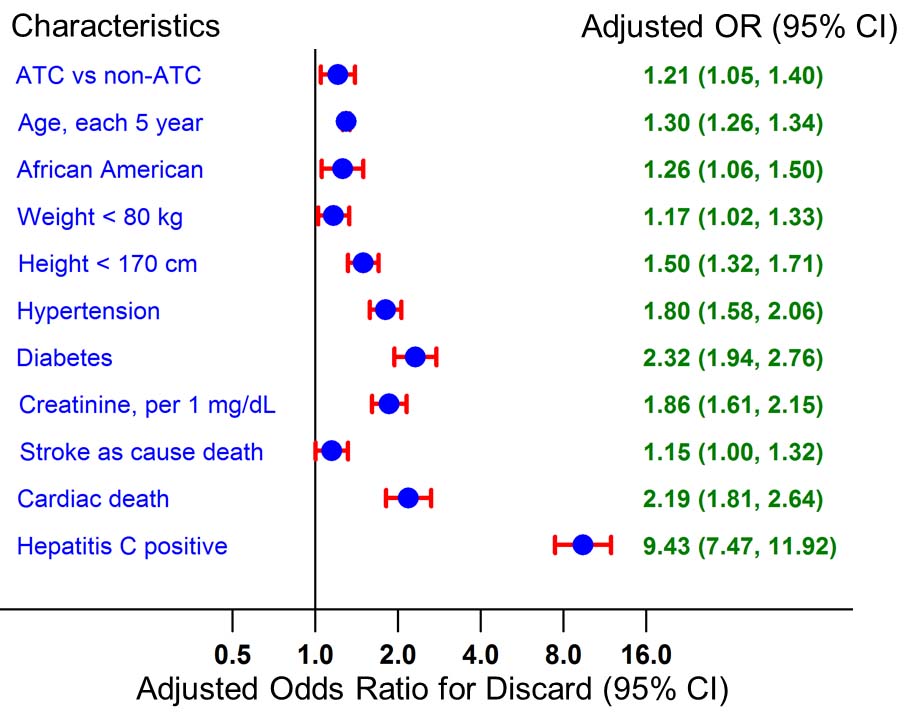The American Transplant Congress Effect on Kidney Discard Rates in the United States.
1Mayo Clinic, Scottsdale, AZ
2University of Utah, Salt Lake City, UT
Meeting: 2017 American Transplant Congress
Abstract number: A88
Keywords: Kidney transplantation, Procurement, Risk factors
Session Information
Session Name: Poster Session A: Deceased Donor Issues I: Allocation, KDPI and Recipient Selection
Session Type: Poster Session
Date: Saturday, April 29, 2017
Session Time: 5:30pm-7:30pm
 Presentation Time: 5:30pm-7:30pm
Presentation Time: 5:30pm-7:30pm
Location: Hall D1
Background: Deceased-donor kidneys with high kidney donor risk index (KDRI) are often discarded despite evidence that certain candidates would have better survival accepting these kidneys rather than continuing to wait. A recent study also found kidneys procured on weekends are more often discarded, presumably due to resource limitations on weekends. In addition, many transplant providers attend the American Transplant Congress (ATC), which likely affects staffing, but discard rates and outcomes during these meetings are unknown.
Methods: Using national registry data, we determined rates of kidney discard, delayed graft function (DGF), graft failure and mortality from 2000-2015 during ATC dates compared with the same days of the week in the 2 weeks before and after (non-ATC). Controlling for the 10 KDRI characteristics, we then determined the independent ATC effect on these outcomes using a population-averaged generalized estimating equation.
Results: From 7902 donors (1575 ATC, 6327 non-ATC), 12,588 recipients were transplanted (2455 ATC, 10,133 non-ATC) and 2666 kidneys were discarded (582 ATC, 2084 non-ATC). There were no significant differences in donor, transplant or recipient characteristics by ATC/non-ATC dates. ATC kidneys were more often discarded (19% vs. 17%, p=0.006; adjusted odds ratio 1.21, 95% CI: 1.05-1.40; see Figure). Compared with non-ATC kidney discards, ATC discards were more often pumped and from donors that were female but were less often hepatitis C positive. For kidney transplants, there were no significant differences by ATC/non-ATC dates for DGF (22% overall), graft failure or mortality.
Conclusions: Based on a 21% increased risk of discard, the ATC effect may result in 5 additional kidney discards during these discrete few days each year. Such relatively small numbers could have substantial effects on total life years saved, however, and are important to individuals on the waiting list considering each day, 22 die and many are removed from the list due to worsening health on dialysis. Innovative staffing and logistical solutions may be needed to address this unwelcome side effect to one of our most important annual transplant meetings.
CITATION INFORMATION: Abdelwahab D, Wei G, Hall I. The American Transplant Congress Effect on Kidney Discard Rates in the United States. Am J Transplant. 2017;17 (suppl 3).
To cite this abstract in AMA style:
Abdelwahab D, Wei G, Hall I. The American Transplant Congress Effect on Kidney Discard Rates in the United States. [abstract]. Am J Transplant. 2017; 17 (suppl 3). https://atcmeetingabstracts.com/abstract/the-american-transplant-congress-effect-on-kidney-discard-rates-in-the-united-states/. Accessed December 20, 2025.« Back to 2017 American Transplant Congress
